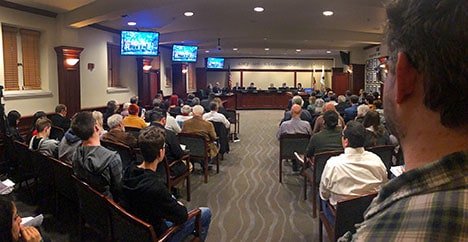City council narrowly chooses new district map, 3-2

After weeks of deliberating, the Claremont City Council decided on a district map for future municipal elections.
The city council narrowly voted 3-2 Tuesday to approve map 124a, which was drafted by National Demographics Corporation (NDC). Mayor Corey Calaycay, Councilmembers Ed Reece and Jed Leano voted in favor, while Mayor Pro Tem Larry Schroeder and Councilmember Jennifer Stark voted against it.
While the council still has to approve the ordinance at its second reading, Tuesday’s meeting was the crescendo of a whirlwind 90-day process that began in November.
Map 124a features a combination of “regional” versus “vertical” map styles, and was presented as a compromise between the two approaches. The proposed regional maps grouped neighborhoods with shared interests in districts geographically, while the vertical map styles presented districts in longer strips from top to bottom in an effort to create more diverse voting blocks.
The council decided to hold council elections in districts one and five for 2020. Mr. Calaycay and Mr. Schroeder both live in district one, though Mr. Schroeder announced Tuesday he will not seek re-election. The three newly elected councilmembers reside in each of the three remaining districts—Mr. Reece in district two, Ms. Stark in district three and Mr. Leano in district four.
Map 124a slices the Claremont Colleges into three separate districts—almost all of Pomona College will be in district five, while the others would be split between districts two and three. Doug Johnson of NDC noted the Colleges represent a high population, but a small number of actual voters. Keck Graduate Institute will be in district one.
Pilgrim Place will be split into two, per the request of a number of Pilgrims, including Gene Boutilier, who noted at the January 24 meeting that the retirement community should be split so more council candidates could campaign there.
The Village will also be split up between three districts. The “old Village” commercial area will be in district five, with Village West in district one. The residential part of the Village will be split between districts three and one by Indian Hill Boulevard.
This was a point of contention for Mr. Schroeder, who favored map 110, a “regional” style map that had the entire Village in one district and all of south Claremont in another.
Ms. Stark favored map 114a, a vertical map that was the only one that split south Claremont in two equal areas. She “bristled” at the idea of south Claremont as one large district.
“To me, having two different people represent you does not mean you’re at odds with each other,” she said. “It actually means you’re creating more collaboration together.”
Two districts in South Claremont, Mr. Schroeder said, simply splits a group in half.
“I think you dilute your voice by doing that,” he said.
Mr. Calaycay and Mr. Reece both favored map 124a, with Mr. Leano touting it as his second choice.
During public comment, 21 people spoke on the topic. As far as map preference, six people like south Claremont in two districts, and six wanted the area to vote as one.
Sue Keith, who lives in south Claremont, urged the council to adopt a regional map and warned that a vertical map could still result in no south Claremont residents on the council. “You have a chance to give us a seat at the table,” she said.
Bob Gerecke, who also lives in south Claremont, was in favor of a split region, noting that grouping south Claremont into one district would reduce, rather than increase the area’s influence on the council.
“That’s not the intent, but that will be the result,” he said.
City officials claimed throughout the process that Claremont was in danger of getting a demand letter, which would force the city to make the transition. No formal demand letter was received, but City Attorney Joseph Larsen said at last week’s meeting that an “oral communication” from the Southwest Voter Registration Education Project was received by the city in September 2018.
During public comment, Jim Belna challenged the city and council to make public any written record of the threat. Mr. Calaycay said he was in favor of transparency, but on the advice of legal counsel, “I’m going to stand by the statement that was made, and I’m not going to comment further in regards to the request for me to make a further statement and what led us to this situation.”
The second reading of the ordinance will take place on February 26.











0 Comments